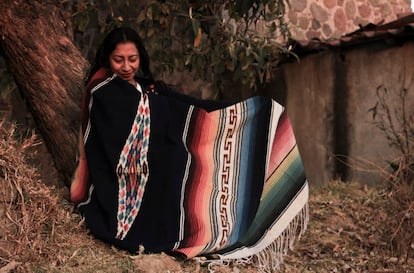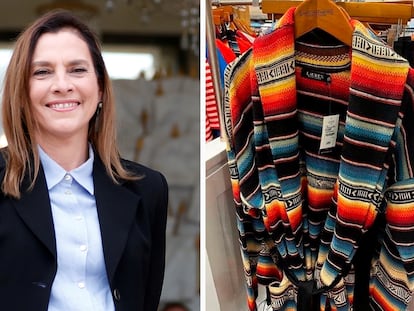Ralph Lauren: Why pulling designs culturally appropriated from Mexico’s traditional serape isn’t enough
Laws remain inadequate for protecting cultural heritage, while communities demand that companies provide compensation and acknowledge their years of work

The Ralph Lauren company recently announced that it had “immediately” pulled the jacket it made using the design of a traditional Mexican textile known as a serape, which originates from the towns of Contla, Tlaxcala and Saltillo, in the state of Coahuila. The fashion house’s move came after Mexico’s first lady, Beatriz Gutiérrez Müller, called the company out on social media for “illegal and immoral” cultural appropriation. But is the company’s prompt response of pulling the jacket from stores enough? If brands like Carolina Herrera and Comme des Garçons have already culturally appropriated the serape, will Ralph Lauren’s decision to stop selling the jacket silence critics in the new media?
For some experts and organizations that work with native communities, the company’s reaction seems more like a display of strength than an act of contrition. “Pulling the product from the market is a way of demonstrating their power. It’s like saying: I can pull these designs from my stores, and it doesn’t matter to me, and there are no repercussions [for the company],” says Andrea Bonifaz of the Impacto organization. For the past nine years, Impacto has focused on defending ancestral and artisanal communities and denouncing cases of cultural appropriation. “A human rights violation like this has to be redressed in other ways. We talk about the three ‘c’s’: commercial collaboration, to which the communities are very open, financial compensation and, of course, due credit to the communities whose heritage has been stolen.”
Carolina Agudelo – a master textile designer and consultant in creation and materials for designers and companies in Latin America – agrees with Bonifaz. “There is no punishment for taking a garment like this off the market. Companies pull the designs they’ve manufactured and then what happens? They burn them! Or, even worse, they end up throwing them away in a desert in South America, causing double the amount of harm. This attitude only shows that we are talking about an immediate industry that produces clothes and doesn’t care if it sells them or not.”
Textiles serve as books in indigenous communities: Agudelo talks about a “textile text.” That is to say the textiles relate the communities’ traditions and daily lives, and they perpetuate the ways in which their ancestors communicated through knots, braids and threads. “They’re a way of communicating with life, time, and the past, which the design departments of these big companies are overlooking. In a world where images are on the Internet and seem to belong to everyone, regardless of their roots, these brands should have historians, anthropologists and sociologists to help designers avoid crossing a line. Because that’s important today; while exoticizing indigenous people has been done for centuries, today, indigenous communities have a voice, and the younger consumer does not forgive that disregard. It’s time to move from indignation to action and pressure the fashion companies, so that there is some kind of compensation and they change their ways.”

From the perspective of the artisans themselves, on top of the financial harm these practices cause (boutique pieces sell for 4,000 pesos, while the items can be purchased in traditional markets for 200 pesos), there is another more significant issue: they see the companies’ activities as “plundering.”
“It is not just a matter of violating agreements; it’s a matter of respect, of empathy. But now at least we express ourselves and raise our voices to tell them: you are taking what is not yours! We are at a stage of transition, of international recognition of the things that have historical and cultural value for the people,” says Ignacio Nezahualcóyotl, a textile artisan from Contla, Tlaxcala, where the traditional serape is produced.
However, the transition of which Nezahualcóyotl speaks is not yet fully protected by national laws and international agreements. These are still insufficient for securing redress and compensation when big companies like Ralph Lauren culturally appropriate indigenous designs.
“These ancestral expressions, like the serape, are collective; that’s the problem when it comes to protecting them, because when they are covered under patrimonial law, the law is designed to protect individuals, not communities. In Mexico, the law for protecting the cultural heritage of indigenous and Afro-descended communities ensures that a community can determine the use and reproduction of some [forms of] expression, but it never defines who or what the community is, so the law has no subject. There are ethnic groups in five different states, and they each have very different organizational structures; the structure is so complex that you cannot include it in a definition of community,” explains Bonifaz.
Attorney Alexander Parra, who coordinates the intellectual property program of Artesanías de Colombia, concurs. “Indeed, the Mexican standard does not allow an indigenous community to collectively hold a trademark. The community has to be organized as an association. For example, in Colombia an indigenous community can collectively hold a trademark, which makes management and legislation easier,” he explains. The attorney travels around the world to advise on how to protect these artisanal and ancestral creations with a protected designation of origin (PDO).
“The better protected [with legislation] we are as countries, the more companies are going to discourage committing these violations. However, in order to obtain an artisanal PDO, as Europeans have done for wine and cheese, the following requirements must be met: first, there must be a specific geographic area where the crafts are produced. Second, there must be sustainable and sufficient administrative and economic organization in place to bring together a majority of artisans in that community. Then, there must be a unique natural and human factor that demonstrates that an object can only be produced in that place, because of the resources and talent of its people,” says Parra. But these requirements, especially the need to organize the communities, are not easy to meet. Currently, Colombia has 12 PDOs for handicrafts. Peru has one, Chile has four and Mexico has three: amber, from Chiapas; Talavera [pottery/ceramics], from Puebla, and hand-painted boxes, from Olinalá.
Faced with the law’s complexities and shortcomings, indigenous communities have begun to try a different approach: seeking mediation as opposed to legislation. An arbitration process is currently underway between the Japanese brand Comme des Garçons and an indigenous community; it seems to demonstrate the effectiveness of that process.
A few days before the launch of its spring-summer collection 2022-2023, Japanese designer Rei Kawakubo’s brand approached the Mexican artisans who created the serape to negotiate. A few years ago, after seeing a Jamiroquai video in which singer Jay Kay wore a colorful poncho, the company discovered that it was a Mexican textile. However, it overlooked the fact that the product was handmade and heavily based on identity in Mexico. “The serape is made with rainbow lines, hues that combine reds, blues, greens, browns, purples; [it’s] a very cheerful display of color. It’s produced with naturally dyed wool, and its distinctive gradient, which is made with small jumps (saltillos) of colors, gives the product its name, serape de saltillo,” Nezahualcóyotl explains.
Comme des Garçons used textiles inspired by the serape’s design, with the same patterns and colors, but manufactured it in a Mexican industrial factory. “At some point, they realized that they were using a traditional Mexican textile, which has existed since colonial times. In order to be able to release the collection without any problems, they offered to pay a paltry amount to compensate the artisans. Then, through government mediation, the community managed to get a fairer compensation payment in exchange for the use of our fabrics, and they also managed to get the serape’s origins acknowledged on the company’s labels,” says Nezahualcoyotl, who led the negotiations with the brand. “This is an unprecedented event. In the history of the cultural appropriation cases that Mexico and other countries have pursued over the years, they have never won compensation before.” The region’s secretary of culture will receive the money, and the amount to be distributed among the artisans will then be determined.
That’s why, despite the public apologies and the Mexican first lady’s approving nod to Ralph Lauren following the company’s quick response, Mexico’s indigenous communities want more than words. They want fashion brands to acknowledge that some traditions, heritage, and cultural history are sacrosant before they commit the violation in the first place.
Tu suscripción se está usando en otro dispositivo
¿Quieres añadir otro usuario a tu suscripción?
Si continúas leyendo en este dispositivo, no se podrá leer en el otro.
FlechaTu suscripción se está usando en otro dispositivo y solo puedes acceder a EL PAÍS desde un dispositivo a la vez.
Si quieres compartir tu cuenta, cambia tu suscripción a la modalidad Premium, así podrás añadir otro usuario. Cada uno accederá con su propia cuenta de email, lo que os permitirá personalizar vuestra experiencia en EL PAÍS.
¿Tienes una suscripción de empresa? Accede aquí para contratar más cuentas.
En el caso de no saber quién está usando tu cuenta, te recomendamos cambiar tu contraseña aquí.
Si decides continuar compartiendo tu cuenta, este mensaje se mostrará en tu dispositivo y en el de la otra persona que está usando tu cuenta de forma indefinida, afectando a tu experiencia de lectura. Puedes consultar aquí los términos y condiciones de la suscripción digital.
More information
Archived In
Últimas noticias
Most viewed
- Reinhard Genzel, Nobel laureate in physics: ‘One-minute videos will never give you the truth’
- Oona Chaplin: ‘I told James Cameron that I was living in a treehouse and starting a permaculture project with a friend’
- Pablo Escobar’s hippos: A serious environmental problem, 40 years on
- Why we lost the habit of sleeping in two segments and how that changed our sense of time
- Chevy Chase, the beloved comedian who was a monster off camera: ‘Not everyone hated him, just the people who’ve worked with him’










































